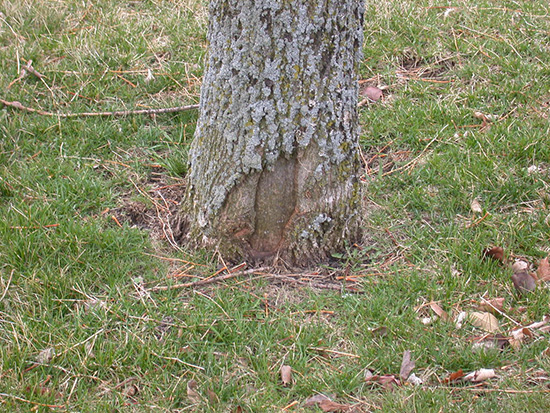Issue 7, June 6, 2016
Mower and Weed-eater Damage
Most tree professionals will tell you the worst plant to be grown around trees is turfgrass. It's not that turfgrass is all that bad for trees, though in nature you seldom find manicured lawns growing around native stands. While the turfgrass may compete for nutrients and waters, it's the mower and weed-eaters that cause the most injury.
While trunks are protected by layers of bark, the bark can be injured easily. Repeated rubbings by the sharp edges of a mower deck, or the line from most weed-eaters, cuts into the bark, eventually reaching the cambium layer underneath. If damage to the cambium is severe; recovery, while possible, has its own issue.

The most outward symptom of the damage is peeling and sloughing of the bark at ground level to five or six inches above the ground. This damage isn't immediate to the mower injury, but may be several weeks, months or even years after the injury occurred. Repeated injury from the mower or weed-eater hastens the symptoms, preventing the tree from trying to heal itself. The bark at the tree's base may swell slightly before it dislodges. Over time, large strips may peel off progressively up the tree, which can be attributed to cambial death at ground level and subsequent inability of the tree to manufacture new bark.
With cambium death, water flow is disrupted and you may notice smaller leaves, small branches, slower growth or even death on the damaged side of the tree. This damage is especially noticeable in the spring as the sap starts rising, the trunk is expanding and the bark is looser.
Often, callus tissue forms, giving the wound a rounded appearance but exposed wood beneath may start to rot. This rotting affects the lower structural integrity of the tree and can be as problematic in the long run as the lost bark.
The best way to prevent the damage is to keep all mowers and string-trimmers away from the trunk of the tree. Mulch two to four inches deep at the most. Ideally, mulch should be spread to the tree's dripline. Practically, a two to three foot radius from the trunk is sufficient, making sure to keep the mulch an inch from the trunk to allow the trunk to stay dry.
The goal is to prevent grass from growing next to the trunk. Low-growing, non-mown groundcovers are an alternative if mulching isn't practical.
Non-selective herbicides can be used in some situations, but protect the trunk of the tree with a cardboard collar when spraying. Make sure to read and follow directions on the label. Avoid herbicides with a long residue as these may damage the tree.
For damage that is already occurring, first change the mowing and weeding strategies. Next, make sure the wound is clean and rounded, as rounded wounds heal faster than jagged ones. A sharp pruning knife may be the best tool. Most fungicides and wound dressings are of little value once the damage is seen. Maintaining the overall health of the tree with watering during droughts and autumn fertilizing is encouraged. (David Robson)
Author:
David Robson